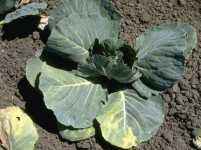Fight Plant Pathogens With Fertility

Nutrient management is an integral part of cultural control and can be adjusted in order to benefit plants. In addition to that, when plants receive a balanced nutrient supply, they are much more tolerant to diseases and show increased protection against new infections, and a significant reduction of any infections they may already have.
Nutrition affects the speed at which a plant’s defenses react to attack from disease. It not only influences the structure and development of the plant, but also the process in which a disease can enter and damage the plant.
The Function Of Four Critical Elements
Below is an analysis of the function of various nutritional elements as well as their relationship with the infection process in plants.
- Nitrogen (N): High quantities of nitrogen provide growth at the young, succulent stage of the plant, which extends the vegetative stage and slows down plant maturity. On the other hand, if there is a nitrogen deficiency, the plants weaken, grow slower, and age faster, which increases their susceptibility to diseases. To give a few examples, lowering the availability of N increases the susceptibility of tomatoes to Fusarium; strong doses of N make watermelons more susceptible to Fusarium oxysporum, and can also increase the attack of Alternaria solani (early blight) in potatoes and tomatoes. Application methods for nitrogen also are important to take note of, and an improper application can lead to Fusarium (wilt and root rot), Plasmodiophora brassicae (root disease in crucifers) and Sclerotium rolfsii (stem rot), which is more serious when you apply it in the form of ammonium.
- Phosphorous (P): By applying P properly in the first stages of plant life, it can contribute to the mooring of flowers, while a deficiency can contribute to a reduction in plant growth and an increase in roots. Additionally, a good supply of the nutrient activates proper plant maturity. Phosphorous is an essential element during the seed formation process where it can be found in large quantities, and when it’s at appropriate levels in the plant, the quality of the fruit increases as well as the plant’s tolerance for diseases. For example, it’s been reported that a proper application of the element can reduce the severity of Streptomyces scabies in potato crops.
- Potassium (K): When you apply K to soil, it’s absorbed in the form of soluble salts such as chloride, sulfates, and potassium nitrate. It’s considered a “mobile” element, as it moves to younger tissues when a deficiency occurs, and a deficiency is typically associated with lowered disease resistance in the plant. For example, a deficiency of K increases the plant’s susceptibility to powdery mildew, while proper levels of K are associated with lessened effects of early blight in potatoes and tomatoes. On the other hand, high concentrations of K increases the attack of cyst nematodes.
- Calcium (Ca) is absorbed in the form of ion. A deficiency is observed as a lack of apical buds. It’s necessary for the formation of the middle layer of cells in the plant, which is directly related to the plant’s resistance to the penetration of disease, and is additionally beneficial to prolonging the shelflife of all fruits and vegetables. Proper levels of Ca reduce the severity of a few root diseases including Rhizoctonia, Sclerotium, Fusarium, and the Ditylenchus nematode.
Phosphites Down On Disease
These compounds have been studied for 40 years and are connected to the processing of phosphites in the form of ion-phosphite when combined with aluminum, calcium, copper, magnesium, manganese, potassium, and zinc, which all promote the natural defense mechanisms of plants in response to disease.
These elements can be considered indirect fungicides and their mode of action is systemic, moving around by means of the xylem and phloem in cells. These compounds are known to have an induced systemic resistance, and the resistance occurs when by stress, or by a pre-infection of a certain disease, the plant becomes resistant to further infection from other pathogens.
The first applications of phosphites were demonstrated with the fungicide Fosetyl-Al, a fungicide which is able to move fluidly from the foliage to the roots by means of the phloem, and it demonstrated control of several root diseases including phytophthora and downy mildews.
Copper phosphite has shown considerable preventative effects against downy mildews and bacteria, while at the same time supplying the crop with phosphorous, a necessary element for flower mooring and fruit setting. Fertilizers based on phosphites ought to be formulated correctly given that they could be phytotoxic, so be extra cautious, or use a certified consultant. In disease management, mineral nutrition is highly important, and nutrients at their proper levels can significantly reduce the attack of pathogenic microorganisms (fungi, bacteria, nematodes, and viruses). Combined with other cultural practices can dramatically increase the overall health of your crops.









